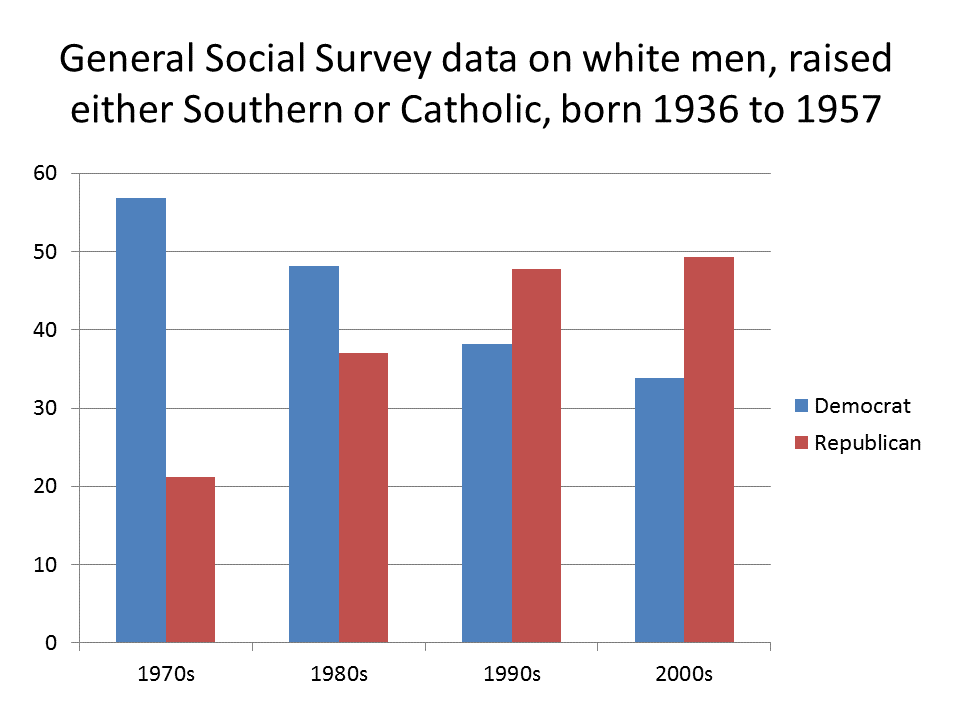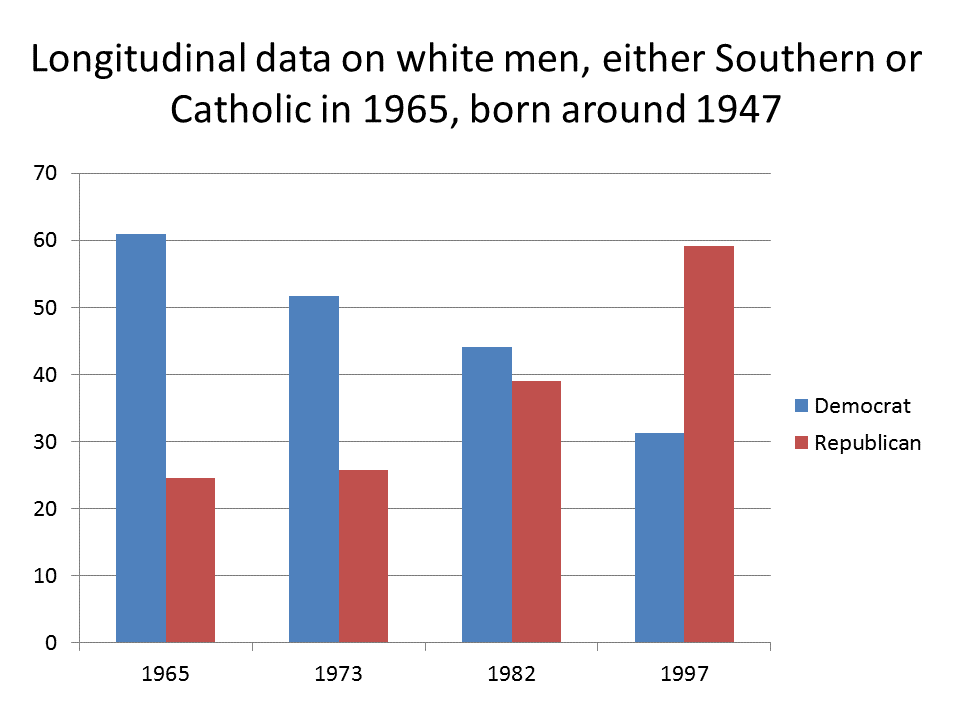Some researchers and commentators have been repeating the line that party preferences are strongly influenced by early political experiences and then relatively stable through later adult years. The problem is that it’s one of those claims that’s true except when it’s not.
For example, Gallup recently highlighted its polling data showing that white seniors have become substantially more Republican in party preferences since 2008 – despite assurances from some theorists that old people rarely switch parties. The parties have shifted in ways that have encouraged these changes among older whites. One of the shifts has involved Republican attempts to paint themselves as the party protecting Medicare (healthcare for seniors, who are overwhelmingly white) from the supposed cuts in the Affordable Care Act (healthcare for poorer people who are not yet seniors, many of whom are not white).
When parties shift to emphasize the views of a given group, often that group follows along. They do so notwithstanding theoretical claims that adult voters generally stay put.
Better-known examples from the last decade include white men who are either Southern or Catholic. Both white Southerners and non-Southern Catholics used to be solidly in FDR’s New Deal coalition. But then Democrats moved to the left on race (starting in the 1960s) and abortion (in the 1980s) while Republicans moved to the right on these issues.
It took decades for elected Democrats and Republicans to sort themselves out on these new dimensions. Sometimes that sorting happened through politicians switching parties, sometimes through politicians changing their old policy views, sometimes through primary defeats for old-timers who didn’t fit the new policy patterns, and sometimes through simple attrition.
These policy shifts, among others, led to substantial movements in certain voting groups’ party preferences throughout the late 20th century – particularly for white, male Southerners and white, male Catholics.
Some of the biggest shifts occurred among those born in the 1930s through the 1950s, many of whom were among the so-called “Reagan Democrats” in the 1980s, despite being well into their adult years. If we look at General Social Survey data for white men born from 1936 to 1957, for example, limiting the sample to those with at least high-school educations who were raised in the South or raised Catholic, we get the party identification levels in the graph below, which shows big shifts from the 1970s to the 1980s (when these men were in their early 30s to early 50s) and further big shifts from the 1980s to the 1990s (when these men were in their early 40s to early 60s).
 This isn’t longitudinal data, though. For that, we can turn to the Youth-Parent Socialization Study. This study began following a group of high-school seniors in 1965, who were born mostly in 1947. They were interviewed again in 1973, 1982, and 1997.
This isn’t longitudinal data, though. For that, we can turn to the Youth-Parent Socialization Study. This study began following a group of high-school seniors in 1965, who were born mostly in 1947. They were interviewed again in 1973, 1982, and 1997.
If we look at the white men who were either in the South or Catholic in 1965, we see patterns very similar to those in the GSS data. If anything, the late-age changes are more dramatic in this longitudinal sample.
 Here, the overall changes are actually quite modest from 1965 to 1973 (when the sample members were around ages 18 and 26, respectively), pick up pace from 1973 to 1982, and stay almost as robust from 1982 to 1997, well past ages where it is commonly assumed that people aren’t very active on the party-switching front.
Here, the overall changes are actually quite modest from 1965 to 1973 (when the sample members were around ages 18 and 26, respectively), pick up pace from 1973 to 1982, and stay almost as robust from 1982 to 1997, well past ages where it is commonly assumed that people aren’t very active on the party-switching front.
In short: As the Republican Party adopted policies favored by white Southern and Catholic men, lots of these folks changed parties. Similarly, as the Republican Party has recently come to prioritize healthcare for white seniors over healthcare for younger and poorer folks, the mere fact of being non-young doesn’t prevent changes in loyalties among white seniors.
Much of the current round of talk about party stability has come in the context of thinking about future voting trends for Millennials and Latinos. But it just doesn’t make a lot of sense to assume that party preferences will be stable without also assuming that party platforms will continue to reflect these groups’ policy priorities. Further, groups’ policy priorities can change as they age. Psychological inertia won’t be enough to ensure future voting continuity from today’s young voters; the evolving policy choices of the parties will, as usual, play a central role.
